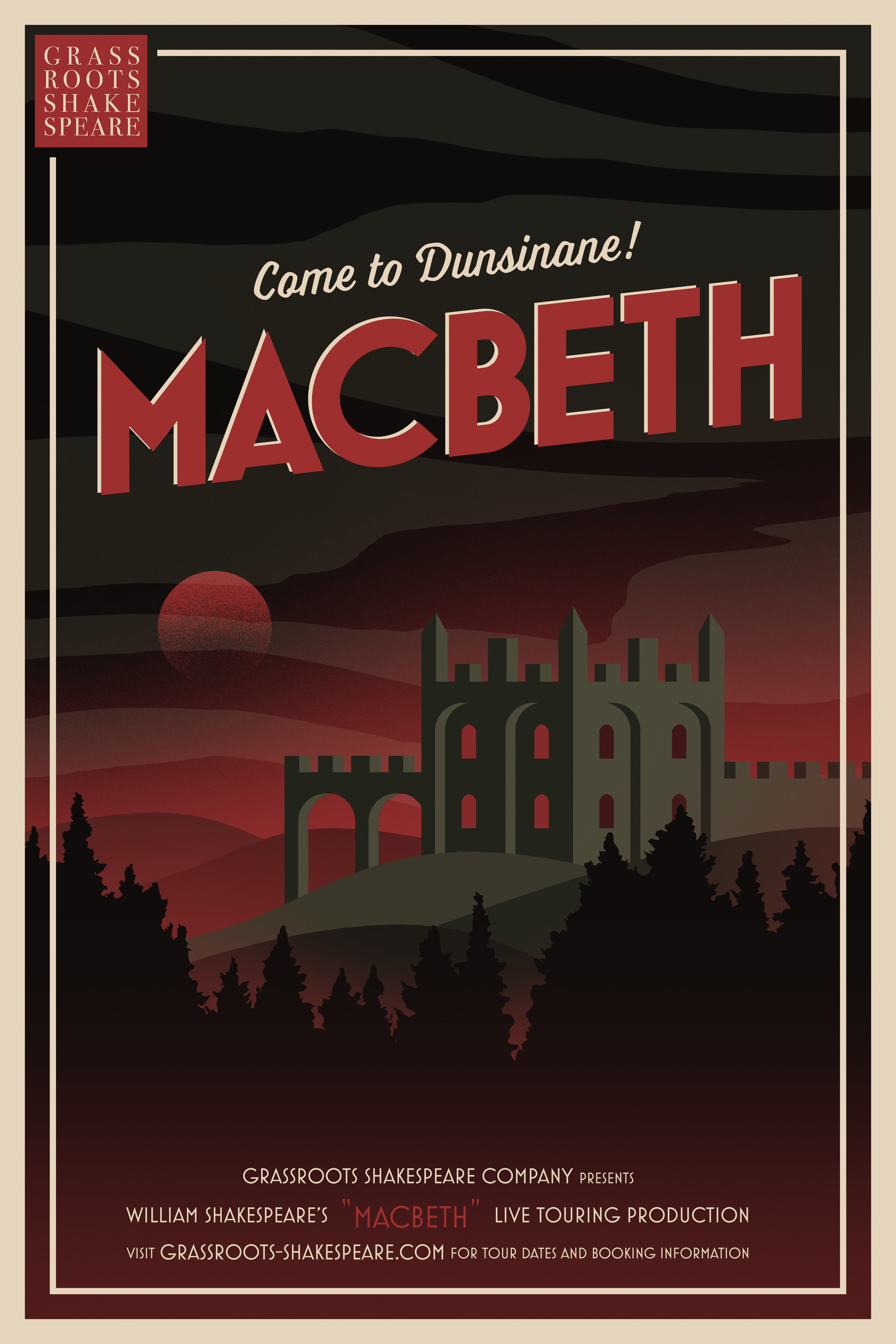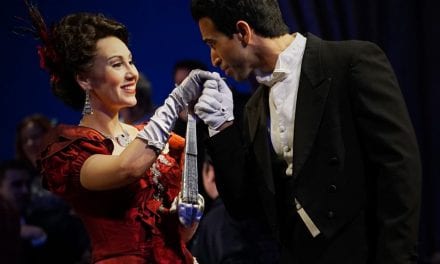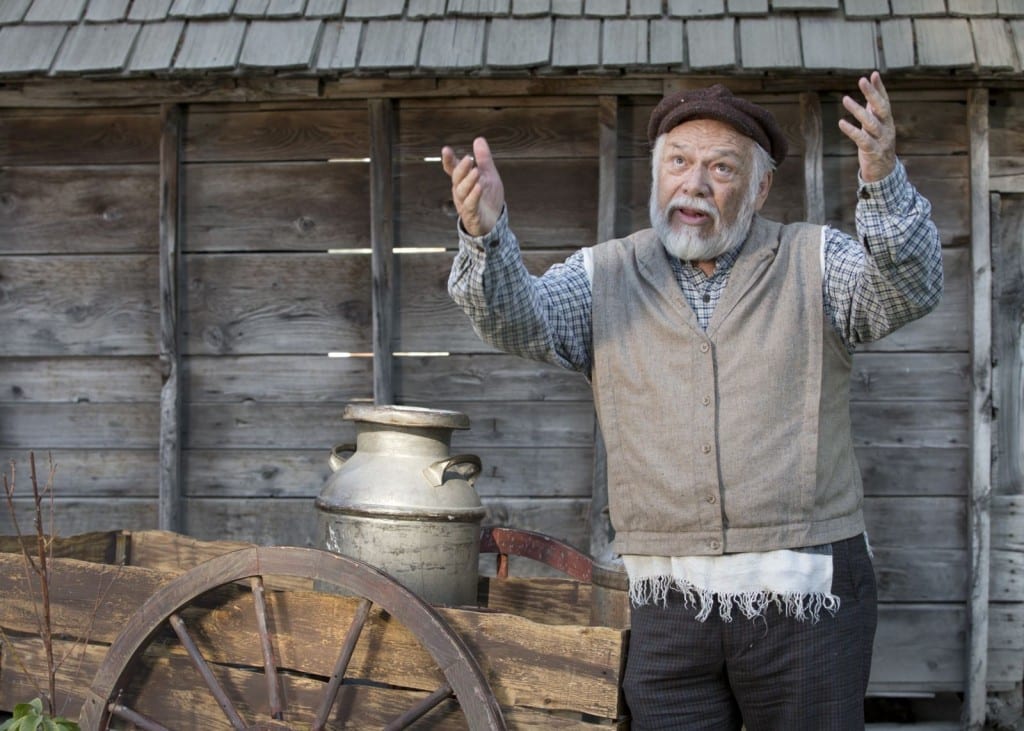SALT LAKE CITY — Also known as The Scottish Play, Macbeth is about one man’s slow descent into ruin and madness. As staged by Grassroots Shakespeare Company, Macbeth is an atmospheric play with live music that plays throughout, an emphasis on audience participation and fake blood that splatters people in the front row as characters are murdered.

Show closes October 28, 2023.
And like the days of old, there is no set for the actors to interact with. The audience must rely on their imagination to envision the location of the action. By and large, this seems mostly effective in large part because Macbeth is a character-driven play that does not rely heavily on setting to establish its story. One of the strongest scenes in the play is when Macbeth (played by Ben Isaacs) is at a dinner party and hallucinates the ghost of Banquo (played by Alex Vaughn) while Lady Macbeth (played by Katherine Moulton) tries to assure the guests that her husband is fine. Though the large table for the scene was simple, it did feel nice to have something real to latch onto so that the scene could be more thoroughly enjoyed, versus struggling to conjure images in the mind’s eye.
Perhaps the most divisive aspect is encouraging the audience to boo, cheer or “aww” at various moments in the play; at one point, the woman next to me announces the impending death of Lady Macduff (played by Sarah Wilkins). Because I had never seen Macbeth before, this ruined the surprise. Additionally, none of the things people shouted out were particularly funny or interesting, and the experience reminded me too much of being in a packed movie theater with people yelling at the characters. The only time the audience interaction was effective was when the drunk Porter (played by Claire Stucki) has the audience shout out, “Who’s there?” every time she begins a knock-knock joke. This bit felt more fun, and inviting, versus being expected to react to things as they happened (or listening to others, who have clearly seen the play before, spoiling the tension).
Some of the best bits in the play are all the fake blood. During each major murder, the actors perform with great abandon to ensure that audience members in the front row get a taste of the action. The actors slash in long, aggressive arcs forcing the blood outward and splattering patrons. Although this is announced before the show began, it is a much different thing to experience it. The blood is fake (so, not the pig’s blood of yore) and is easy enough to wipe off, especially with the handy alcohol wipes provided during intermission after the first time it happens.
Even when the blood stays on the stage, the show has plenty of it. After Macbeth kills Duncan (played by Joseph Wilson), he enters the stage with his hands and knives covered in this fake blood, that is still wet and dripping. There is also Macduff (played by Alyssa Tanner-Vaughn) who is injured in the earlier part of the play, and for a bit, walks around with a bloodied bandage wrapped around her upper arm.
The acting is solid, even for minor characters, but Isaacs is perfectly cast and handles the lead role well. It was mesmerizing watching Isaacs oscillate between confusion and upset after Macbeth murdered Duncan— and then transform into this madman who is certain of his own victory. Late in the play, his eye makeup makes him look deranged or very tired, and it showed the psychological toll of being trapped in Dunsinane castle as the Scottish forces are rising up against him.
All of the costuming is done by the actors, which explains why so much of the wardrobe and styling is reminiscent of Braveheart, but Isaacs and Moulton are the only actors who change outfits throughout the play while still being their original characters. After Duncan’s murder, both Lady Macbeth and Macbeth change into their pajamas to feign ignorance at the news of the murder. As Macbeth ascends into being King, he and his wife have on more sophisticated attire, topped with a crown. Both Macbeth and his wife share a color scheme — black and red — that is maintained throughout the play.
Even though the performance is accompanied with live music, it doesn’t seem to add much to the scenes. There are points in the play where the music seems to become eerie or melancholy, but it is an easy thing to overlook, as the performance progresses and never actually overwhelms the scenes (as in a musical or opera). Also, because the production is so bare-bones, there is a single, bright light that illuminates the stage and never changes color except toward the end when Macbeth murders young Siward (played by Brynne Lamb) and later murdered by Macduff that causes the entire stage to be flooded with red.
The Grassroots Shakespeare Company production of Macbeth attempts to recreate many of the aspects of when Shakespeare‘s plays were first staged, though there are breaks from Elizabethan stage practice, such as allowing women to play the parts of men. It is a different way to experience Shakespeare, though I do not know whether it will appeal to audiences that are used to more elaborate theatre. There are still some technical aspects that add to the show’s spectacle: puppets are used when Macbeth goes back to see the weird sisters about the prophecy, and there are sound effects of knocking, horses running, and screams. This production of Macbeth is like a good entry into the famous play, though I would like to also see Macbeth staged more traditionally to determine which approach is preferred.

These reviews are made possible by a grant from the Salt Lake County Zoo, Arts, and Parks program.




